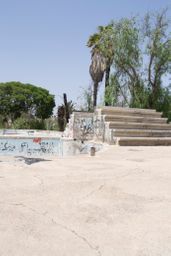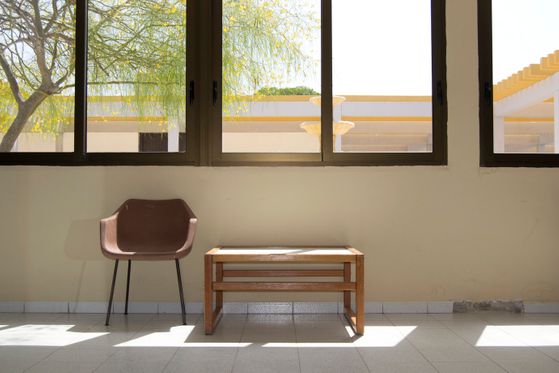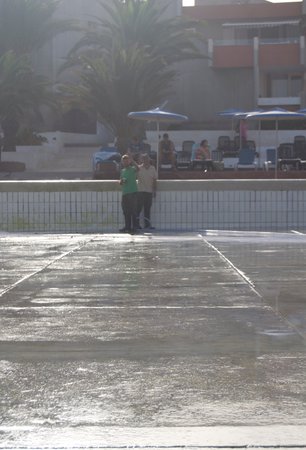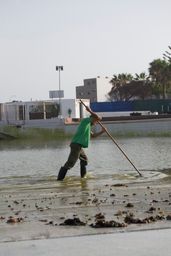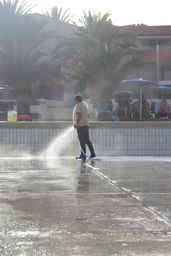B E K V I S
________
G __ r -
A fi SSSSSS
c - h
O °°°°° O O On t w e
r
P !
Project 2015-2017: Ten Bel
Visual Research for University of Antwerp, department of Film and Visual Studies UA, Belgium.
Ten Bel (Tenerife-Belgium) is a holiday resort located in the south of Tenerife. The resort was built in the early ’60 ties as a holiday resort for the fast growing tourism in Europe. With its modernist architecture it became a high-end resort for holiday seekers trough-out the ‘60-’70-‘80. In the mid ’80 ties the park began to decline due to competition and malfunctioning. In 2001 it went bankrupt and was sold into pieces. Inspired by the socio-semiotic analysis of Marc Gottdiener’s ‘Disneyland: A Utopian Space’ this research tries to uncover the meaning system behind the holiday resort of Ten Bel as a case study. The holiday resort and Belgium are analysed trough syntagmatic and paradigmatic associations. In the syntagmatic analysis the resort is contrasted with Belgium. The paradigmatic analysis articulates the growing impact of capitalism in the social formation of Belgium in addition with the ideas of the founder of the resort M. Huygen. By using documentation, communities on Facebook, family archives and self-generated imaginary this analysis has also a strong emphasis on the visual aspects of research.
‘(…) et qu’enfin à l’horizon de toutes ces visions ou quasi visions, c’est le monde même que j’habite, le monde naturel et le monde historique. Avec toutes les traces humaines dont il est fait; autant cette convictions est combattue, dès que j’y fais attention, par le fait même qu’il s’agit là d’une vision mienne.’
- Maurice Merleau-Ponty, Le visible et l’invisible. p. 19
‘Een geslaagd object, in de zin dat ze bestaat voorbij haar eigen identiteit, is een object dat een duale relatie tot stand brengt, een relatie die kan ontstaan door middel van misleiding, van contradictie, van destabilisatie, maar die in feite de zogenaamde realiteit van een wereld confronteert met de radicale illusie ervan.’
- Jean Nouvel en Baudrillard, Unieke objecten, Klement/Pelckmans, 2014, p. 23
'The landscape becomes a magical object, an idol that demands human sacrifices, a place where symbolic, imaginary, and real violence implode on a actual social space.'
- MITCHELL, W.J.T, Landscape and power.
Project 2015-2017: Youth
Visual Research for University of Antwerp, department of Film and Visual Studies UA, Belgium.
Paulo Sorrentino’s film ‘Youth’ ademt een fin de siècle gevoel uit vergelijkbaar met het wereldberoemde boek ‘De Toverberg van Thomas Mann uit 1924. Twee boezemvrienden op leeftijd verblijven in een luxueus kuuroord ten midden van de idylle van het Zwitsers Alpenlandschap. Ze genieten er van de rust, het eten, massages, gesprekken, lange wandelingen en contempleren daarbij over het rijke leven dat ze hebben geleefd. Michael Caine speelt een gevierd Britse componist (Ballinger) en Harvey Keitel speelt een Amerikaanse cineast (Boyle) die zijn laatste film wil afwerken maar in een creatieve impasse zit. Rachel Weitz speelt de dochter van Ballinger, Lena, die in een huwelijkscrisis is beland en haar vader opzoekt voor steun. De film eindigt met de zelfmoord van de cineast en met Balliger die na lang aandringen van de Queen of England zijn gevierde compositie ‘Simple Songs’ toch wil uitvoeren. Beide heren staan daarbij metafoor voor een Westerse cultuur die moe is en zich terugplooit op zichzelf. De Zwitserse Alpen en het Berghotel Schatzalp vormen daarbij de culturele achtergrond. De twee op rust zijnde sterren worden geportreteerd in een stillistisch als nostalgisch beeldenballet waar heel wat meer over te zeggen valt dan op het eerste zicht lijkt.
'Memory and its representations touch very significantly upon questions of identity, of nationalism, of power and authority.'
- SAID, E., Invention, Memory and place, in: MITCHELL, W.J.T, Landscape and power.
© Bekvis en Bert Vissers, 2018. Unauthorized use and/or duplication of this material without express and written permission from this blog’s author and/or owner is strictly prohibited. Excerpts and links may be used, provided that full and clear credit is given to Bert Vissers and Bekvis with appropriate and specific direction to the original content.



